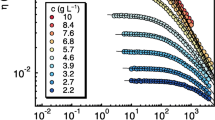Abstract
The maximum alignment angle θeff and the effective rotational viscosity coefficient γ effi of polar liquid crystals, such as 4-n-octyloxy-4′-cyanobiphenyl (8OCB), are investigated in the vicinity of charged bounding surfaces. The quantities θeff and γ eff1 are calculated in the framework of the Ericksen-Leslie theory. The results of calculations demonstrate that, for a homeotropic alignment of molecules on charged indium tin oxide surfaces, the effective rotational viscosity coefficient γ effi can increase by 7.8% as compared to the bulk rotational viscosity coefficient γ1.
Similar content being viewed by others
References
J. L. Ericksen, Arch. Ration. Mech. Anal. 4, 231 (1960).
F. M. Leslie, Arch. Ration. Mech. Anal. 28, 265 (1968).
P. G. de Gennes and J. Prost, The Physics of Liquid Crystals, 2nd ed. (Oxford Univ. Press, Oxford, 1995; Mir, Moscow, 1982), p. 360.
A. V. Zakharov, Phys. Rev. E 51, 5880 (1995).
J. N. Israelachvili, Intermolecular and Surface Forces, 2nd ed. (Academic, London, 1992).
A. V. Zakharov and R. Y. Dong, J. Chem. Phys. 116, 6348 (2002).
V. F. Zaitsev and A. D. Polyanin, A Handbook on Ordinary Differential Equations (Fiz.-Mat. Lit., Moscow, 2001), p. 576.
N. Kuzuu and M. Doi, J. Phys. Soc. Jpn. 52, 3486 (1983).
S. A. Rozanski, R. Stunnarius, H. Groothues, and F. Kremer, Liq. Cryst. 20, 59 (1996).
A. V. Zakharov and R. Dong, Phys. Rev. E 63, 011704 (2001).
A. V. Zakharov and R. Dong, Eur. Phys. J. E 7, 267 (2002).
S. Ponti, P. Ziherl, C. Ferrero, and S. Zumer, Liq. Cryst. 26, 1171 (1999).
R. N. Thurston, J. Cheng, R. B. Meyer, and G. D. Boyd, J. Appl. Phys. 56, 263 (1984).
S. Ponti, P. Ziherl, C. Ferrero, and S. Zumer, Liq. Cryst. 26, 1171 (1999).
A. G. Chmielewski, Mol. Cryst. Liq. Cryst. 132, 319 (1986).
Author information
Authors and Affiliations
Additional information
__________
Translated from Fizika Tverdogo Tela, Vol. 45, No. 6, 2003, pp. 1135–1140.
Original Russian Text Copyright © 2003 by Zakharov, Vakulenko.
Rights and permissions
About this article
Cite this article
Zakharov, A.V., Vakulenko, A.A. Shear flow of a nematic liquid crystal near a charged surface. Phys. Solid State 45, 1191–1196 (2003). https://doi.org/10.1134/1.1583813
Received:
Accepted:
Issue Date:
DOI: https://doi.org/10.1134/1.1583813




